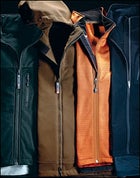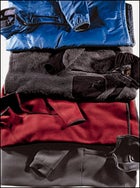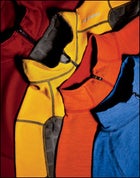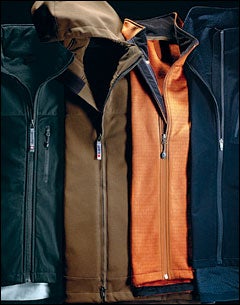Whether you’re looking to replace a retired (or just tired) jacket, buy your first pair of soft-shell pants, or upgrade everything in between, the newest layers will make you rethink your adventure wardrobe. This season’s top piecesincluding versatile merino-and-synthetic hybrids and fleece garments with the thermal properties of animal furlet you dress lighter while staying comfortable in a wider range of conditions. Check it out; your closet may need a refill.
Jackets

From left:
Marmot Super Hero
Going outside, forecast be damned? Put on this windproof, water-resistant jacket and don’t look back. It’s made with a smart patchwork of Gore Windstopper fabrics and has a brushed lining to help insulate your core, while underarm swaths of knit polyester increase breathability. When I got caught in an intense hailstorm in Colorado, the roll-away (and detachable) hood easily shed the pellets, and the cinchable cuffs and hem sealed out drafts. Layering tip: The jacket performs best when paired with a lightweight base layer. $260;
Blurr Public Hoody
If soft shells start popping up in hip-hop videos, blame Blurr. Just don’t accuse the street-inspired Canadian company of compromising function. This jacket’s abrasion- and water-resistant exterior can handle a lot worse than the dash from curb to club, and a deceptively functional hood fits and adjusts with ease. The garment’s new-school cut is bulkier than other jackets here, and hidden internal fleece gaskets at the wrists make it warmer but a bit less breathable. Ultralighters, take note: The Public Hoody is the heaviest of the bunch. $200;
The North Face Blackhawk
TNF claims that its WindWall fabric (a fleecy inner face bonded to a breeze-blocking barrier) is ten times more wind-resistant than regular old fleece. After wearing the Blackhawk on a hike in 50-degree weather, I figured that was marketing hypethe stuff is just too breathable. But I became a believer when the jacket repelled all but the most powerful gusts during a Wisconsin storm with 40-mile-an-hour winds. MIA: a hem drawcord, which should be standard equipment with this level of protection. $179;
Ibex Dash Hybrid
Some purveyors of fine merino wool would have us believe that blending the stuff with synthetics is sacrilege. My view after using the poly-and-wool Dash in the cold and wet? Score one for the heretics. I stayed warm and dry behind the smooth-faced front, while the breathable knit back and underarm panels, which include a touch of Lycra for stretch, kept me from overheating. With a trim cut, longer-in-back hem, and rear pocket, this jacket favors biking and nordic skiing, but it’s great for anything. Bummer: no hand pockets. $170;
Midlayers
Midlayers

From top:
Outdoor Research Fraction Pullover
Everyone should own a PrimaLoft-filled jacket. Unlike delicate down, the synthetic insulation doesn’t turn to mush when it gets wet. The Fraction’s spare design and just-enough stuffing make it much more compressible than a midweight fleece yet warm enough for cold-weather camping or belaying. Bonus: The DWR-treated polyester shell fended off an hour of Wisconsin drizzle. $129;
Mountain Hardwear Mastiff Pullover
Ignore the Sasquatch jokes: The Mastiff’s beastly shag hides serious science. The fluffy material is Polartec’s new Biomimicry fleece, which imitates animal fur. Longer guard hairs” on the exterior create loft, while denser inner fibers trap warm air, giving the highly compressible Mastiff the best warmth-to-weight of any fleece I’ve worn. Stretchy side panels, thumb loops, and a cinchable neck round out the techy features. $140;
Arc’teryx Sniper
Get a midlayer, jacket, and sidewalk cruiser with the three-in-one Sniper. During a ski trip in British Columbia, I was able to easily slide a shell over the fleece’s fitted cut and smooth face. But Polartec’s tightly woven Wind Pro fabric can go it alone, too: It beat back pine trees and stiff gusts in Colorado’s Indian Peaks. And thanks to the subtle, sweaterlike herringbone weave, the Sniper can pass muster off the mountain as well. $150;
Smartwool Synergy Zip T
After years of being faithful to natural fibers, SmartWool has hopped in the sack with synthetics, and it’s been a fruitful affair. While ski-touring in the Tetons, I stayed warm and dry thanks to the Synergy’s 100 percent merino liner, while the smooth nylon-and-poly face acted like a built-in wind shirt. The extra-tall collar is a blessing when things get nasty, and the welded chest pocket is placed high so you can access small essentials without undoing your pack’s sternum strap. $150;
Pants
From top:
Prana Expedition
Take your favorite wind pants and add a touch of fleecy insulation and stretchy Lycra and you’ve got the Expedition, the most versatile cold-weather pants I tested. Above tree line in Colorado, they kept me warm in camp in subfreezing temps. The next day, while hiking in 50-degree sunshine, I only needed to crack the below-the-knee vents to stay comfortable. Demerits: The lined fabric is a little slow to dry, and the thigh pocket is oversize and poorly positioned. $100;
Patagonia Simple Guide
If you’ve pared down everything else in your layering system and want pants to match, this minimalist version of Patagonia’s time-tested Guide is an easy choice. With lighter-weight fabric and fewer features (no scuff guards or ankle zips), the Simple Guide shaves almost half a pound off the original. Both versions benefit from an upgraded stretch-woven material that increases resistance to abrasion and water. Get the revamped Guide ($145) if you need something that can double as a backcountry ski pant. $125;
Ground Pinnacle
Judging by the recent profusion of tapered, only-in-black soft-shell pants, you’d think there were a contingent of rock-climbing Goths driving the market. The Pinnacle bucks the trend with a jeans-style cut and color options. I abused them for the better part of a monthfrom bushwhacking below tree line to postholing in wet spring snowand they still look new. The quick-drying Schoeller Dryskin fabric has an armorlike Nanosphere finish that repels water, mud, and marinara sauce with equal effectiveness. $165;
Cloudveil Run Don’t Walk
Would you rather freeze than wear tights? Stop shivering and try these crossovers. Smooth-faced Polartec Power Stretch fleece performs like cold-weather tights, but thanks to a relaxed cut, back pockets, and a magnetic-buckle waist belt, they feel like your favorite chinos. I wore them on a chilly trail run, then did something I’d never do in standard-issue leg-huggers: went straight to the grocery store. The fabric isn’t as water-resistant as others here, but it’s warmer and more breathable. $105;
Base Layers
Wool vs. Synthetic: A shortcut guide to the base-layer smackdown
Merino WoolWarmer when wet
Fights body odor better
More eco-friendly resource
Looks better with jeans
Synthetic
Wicks moisture away faster
Dries more quickly
Better warmth-to-weight ratio
Costs less
Base Layers

From left:
Mountain Hardwear Extend Midweight Zip T
Synthetic base layers have plenty of advantages over wool (see above), but odor control isn’t among them. The best stink defense we’ve found is Visa Endurance, used on the eXtend line and others. The yarns release silver ions that prevent the spread of funk-causing bacteria. $55;
Sugoi Wired
Base layers, like everything else, are getting the iPod treatment. The midweight synthetic Wired comes with an integrated digital audio pocket on the sleeve. Anything heavier than an iPod Mini will slosh around, but then you probably shouldn’t be out running with your 40-gig player, should you? $70;
Helly Hansen Freeze Zip Turtle
This hybrid pairs a synthetic inner liner with a merino-wool exterior to capture some benefits of both. Lifa fabric inside wicks moisture from the skin, while the wool outer adds warmth. $75;
Patagonia Wool 2 Zip-Neck
This fall, Patagonia joins the ranks of SmartWool, Ibex, Icebreaker, and others by offering a full line of 100 percent merino base layers. The company’s new wool line is not quite as soft as the finest fabrics on the market, but for good reason: The material is prepped with a process called slow washing, instead of being treated with environmentally unfriendly chlorine. $88;


